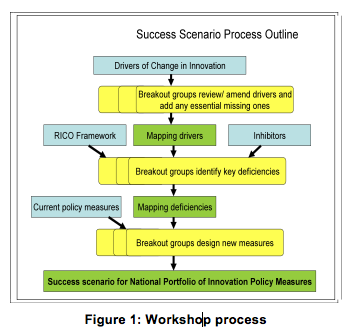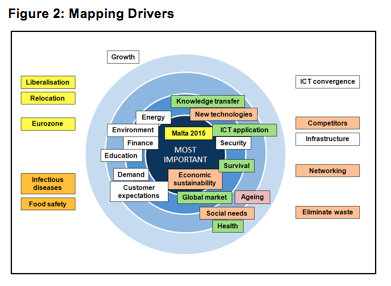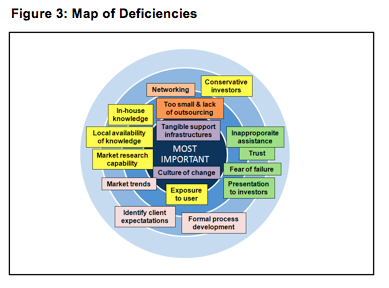The brief describes the design and implementation of a success scenario workshop used in Malta to allow industry to give a foresight-based input to the design of innovation policy. The exercise drew upon the results of several industry-level studies in the small new EU member state aimed at identifying the drivers and inhibitors of private sector R&D and innovation investments.
Re-designing Regional Innovation Strategy
The exercise drew upon the results of several industry-level studies in Malta aimed at identifying the drivers and inhibitors of private sector R&D and innovation investments.
The segmentation of this micro-ecosystem into three types of firms – start-ups, SMEs and large firms – linked by a complex network and common framework conditions, provided the backdrop for a future-oriented exploratory exercise that considered the implications of the drivers of R&D and innovation in future markets, products, processes and services.
The brief describes the methodology and results of this workshop aimed at designing creative measures for innovative futures and hence encouraging firms to increase the level and effectiveness of their R&D expenditure. Lessons for the use of the success scenario approach for innovation are discussed.
Innovation is a key to the survival and growth of businesses in the present global competitive environment. Yet for many firms it remains a daunting challenge. Government today recognises that it must provide the conditions in which enterprises can flourish, and this includes provision of policies and support measures that help firms bring successful innovations to the market. Some policy measures in this area are longstanding, but the changing environment means that there is a need for constant review and adaptation to meet firms’ current and future needs.
The Futurreg Project
At the time this exercise was undertaken, Malta was reappraising its innovation policy support framework. The national agency responsible for enterprise support and innovation (Malta Enterprise) was developing a regional innovation strategy (MARIS).
Futures approaches were applied as part of this innovation strategy through Futurreg, an Interreg3c project aimed at promoting the use of foresight in ongoing regional development projects. The other main actor was the Malta Council for Science and Technology, which represented the Malta partner in Futurreg. The Council provided foresight support to MARIS and used the project to consult business and other stakeholders on necessary measures to support future innovation needs. This brief describes the findings of a success scenario workshop that had three aims:
- to define a broad framework for a future-oriented national innovation policy,
- to create an enhanced and shared understanding of the drivers of innovation,
- to explore success scenarios and design new measures tailored to the specific needs of three types of Malta-based companies (see below).
The workshop brought together major stakeholders in innovation, including business leaders representing the three targeted groups of firms, public entities and other agencies supporting local business, and university experts. The basic idea was that by looking at drivers of innovation in the future and by identifying key deficiencies of firms in Malta in their ability to respond to these drivers, it would be possible to design policy measures that would address those deficiencies in the most effective way. In advance of the workshop and in consultation with stakeholders, a number of key drivers of innovation were identified, including economic, political, environmental, security, health, social change and ICT factors.
Success Scenario Workshop: Action-based Approach
The success scenario approach used was developed at the University of Manchester and has been applied in exercises setting UK national strategy for ICT, biotechnology and nanotechnology as well as in policy-related areas such as university-industry links (Cassingena Harper and Georghiou, 2005), international scientific cooperation policy (Georghiou et al., 2006), infrastructure policy (Keenan and Popper, 2007) and the development of the European Research Area. Ian Miles has described the success scenario approach in terms of two elements:
- Desirability: capturing a vision of what could be achieved or aspired to by the sponsoring organisation or the wider community that it represents.
- Credibility: the scenario is developed with the assistance and validated by a sample of experts in the area chosen to reflect a broad range of interests and usually including both practitioners and researchers (Miles, 2002).
It is an action-based approach, with the shared vision among senior stakeholders of what success in the area would look like being specified in terms of goals and indicators, which provide the starting point for the process of developing a roadmap to get there. The purpose of having such a vision of success is to set a ‘stretch target’ for all the stakeholders. The discussion and debate involved develops mutual understanding and a common platform of knowledge that helps to align the actors for action.
Discussion of Drivers of Innovation in Firms
The success scenario workshop on Creative Measures for Innovative Futures convened on 15 May 2007. In line with the national research and innovation strategy developed last year by MCST, where it was noted that MCST and Malta Enterprise have shared competencies in the area of research and innovation policy and need to work together in developing new measures, this workshop provided a setting for creating a synergy of efforts in innovation. The workshop offered an opportunity to bring together the insights of relevant stakeholders from business, academia, government and business support agencies in innovation policy design. There was a good representation of all sectors at the event.
The previous Futurreg-MARIS workshop held in March 2007 highlighted the fact that a number of important initiatives are underway focused on promoting innovation in business, namely the MARIS, METIC and Forlink projects. The local industry studies carried out through these projects identified a number of inhibiting factors to innovation and also a range of opportunities in terms of niche areas to be exploited. The aim of the follow-up workshop in May 2007 was to build on this substantial work and place it in a more futures-oriented context where alternative approaches can be openly identified and discussed.
Figure 1 (below) shows the simplified process of the workshop. Items in blue shading represent the inputs coming from previous stages, yellow shading represents group work and green the plenary sessions. The workshop was attended by 45 experts, drawn primarily from the private sector and government but involving also academia.

In the plenary warm-up session, the key drivers of innovation were presented and discussed in order to identify immediate gaps from a local business perspective. Participants were then divided into three working groups, representing the needs and interests of three main types of firms. Workshop participants felt that innovation policies could best be distinguished by an amended classification of three types of firms:
- Type 1: start-ups
- Type 2: SMEs
- Type 3: large firms
The working groups discussed the key drivers and identified the ones that are most relevant to their future development strategies and visions. They focused on the following questions:
- Which drivers are currently influencing innovation in your sector?
- Which drivers are likely to influence innovation in your sector in the next five to ten years?
- What are the likely future trends in innovation in your sector? In your products? In your services and processes?
- Are any innovation drivers or trends missing?

The plenary session focused on defining the impact of drivers of innovation on each of these types of firms. Participants were then asked to map the drivers according to their level of importance.
The working groups then focused on identifying the main deficiencies to innovation based on the RICO framework, which separates needs into four broad categories:
- Resources: Insufficient resources to undertake the work without public funds, which is generally true for academic research and accepted for business R&D that is either highly uncertain and/or where social returns justify an investment that does not meet private criteria.
- Incentives: Scientific structures or the market provide insufficient incentives for socially desirable behaviour, for example, academic-industrial collaboration. Fragmented or risk averse markets may also obstruct innovation.
- Capabilities: Organisations lack key capabilities needed for the innovation process, for instance, the ability to write business plans or raise venture capital.
- Opportunities: Generation of opportunities for innovation provides one of the main justifications of public support of science. Need also to consider how firms can get hold of such opportunities through knowledge transfer/exchange.
Participants were then asked to map the drivers according to their level of importance. A similar map was produced from a discussion of deficiencies drawing upon an earlier exercise (see Figure 3 below).

In the afternoon, the workshop entered into its more creative phase by using the results of the morning session to design Creative Measures for Innovation Support. Working groups then identified appropriate innovation policies to address the particular needs emerging in their discussion. The final plenary session captured the inputs to define a desired and feasible national portfolio of innovation policy measures and instruments.
Innovation Success Scenario for Malta: Change of Culture and Culture of Change
The Success Scenario for Malta takes as its core theme “change of culture and culture of change” as culture emerged as the key driver of innovation, featuring strongly in relation to the discussion on drivers, deficiencies and measures.
Shared Public-Private Innovation Concerns
The key innovation policy challenge for Malta is defining and spearheading a national political and economic vision in a more coherent and integrated way and ensuring broad societal acceptance. Government and enterprise face a number of innovation challenges relating to growing environmental, energy and security concerns and share a set of systemic concerns regarding improved networking and knowledge transfer across sectors and organisations; this involves links between business and academia in particular. Business and government have an enhanced demand for more innovative solutions to societal needs, sparked by the growing sophistication of needs and the emergence of more intelligent consumers and citizens.
Our Success Scenario Pathway: Synergetic relationships need to be developed between the public and private sectors through closer collaboration between government and business on key innovation concerns. Public innovation support to business could target:
- Engaging stakeholders in implementing a national political vision and renewal while allowing for a dynamic feedback loop and learning.
- Helping firms to innovate and sustain economic growth and profitability and to provide innovative solutions to societal needs; supporting firms in coping in innovative ways with the challenges presented by the physical environment, including energy and infrastructure; providing firms with capacities for providing innovative solutions to specialised customer demand.
- Facilitating access to new technologies and knowledge.
The main features of the emergent success scenario were:
- A political vision on innovation, targeting branding of InnovativeMalta and the provision of innovative solutions for the societal needs spearheaded.
- This will be implemented through a National Innovation Platform and a strategy for capitalising Xon the small country advantage and geostrategic position coupled with the diffusion of a culture favourable to innovation and risk-taking – a ‘can do’ culture.
- An ecosystem of well-networked organisations engaged in mutual learning for self-sustaining growth through the nurturing of constant adaptation and learning processes. This will be supported through a state-of-the-art support infrastructure and an accessible national knowledge platform to provide the springboard for innovation.
- Firms are well-networked to customers at home and abroad and attuned to market intelligence; they scan and make use of enhanced in-house innovation management capabilities.
A series of detailed policy measures targeted to each of the three firm types was also produced.
Innovation Policy: Responding to Drivers of the Future
The success scenario approach is a tool tailored to the needs and realities of senior decision-makers in the public and private sectors while it maximises the chances of engaging real stakeholders at a level of seniority sufficient to implement emerging visions.
The device of a 24-hour workshop only works with extensive preparation to develop framework and contextual information. Innovation policy provides a natural focus for foresight approaches because of the need to respond to the drivers of the future. The framework used needs to be properly grounded in a theory of innovation to ensure that it is not merely an exercise in producing a wish-list.
Iterations and follow-up exercises and activities can provide an ideal opportunity for continuing the discussion on the feedback received, extending the debate to a new cluster of stakeholders or those who were unable to attend the first event. Such activities allow updating the scenarios and recommendations and support reviewing implementation and obstacles to progress.
| Authors: | Jennifer Cassingena Harper jennifer.harper@gov.mt
Luke Georghiou luke.georghiou@mbs.ac.uk |
|||||||
| Sponsors: | DG Regio, EU Commission, Interreg 3C and Government of Malta | |||||||
| Type: | N/A | |||||||
| Organizer: | Malta Council for Science and Technology | |||||||
| Duration: | January-July 2007 | Budget: | N/A | Time Horizon: | N/A | Date of Brief: | September 2007 | |
Download EFP Brief No 187_Using Foresight to Involve Industry in Innovation Policy
Sources and References
Cassingena Harper, J. and Georghiou, L. (2005): ‘Foresight in innovation policy: shared visions for a science park and business–university links in a city–region’, Technology Analysis and Strategic Management 17.
Georghiou, L., Keenan, M., Popper, R., Harper, J., Crehan, P. and Clar, G. (2006): SCOPE 2015 – Scenarios of future science and technology developments in developing countries 2015, Report to European Commission 2006
Miles, I. (2002): Scenarios and Foresight – Towards a Constructive Integration, PREST, mimeo, July.